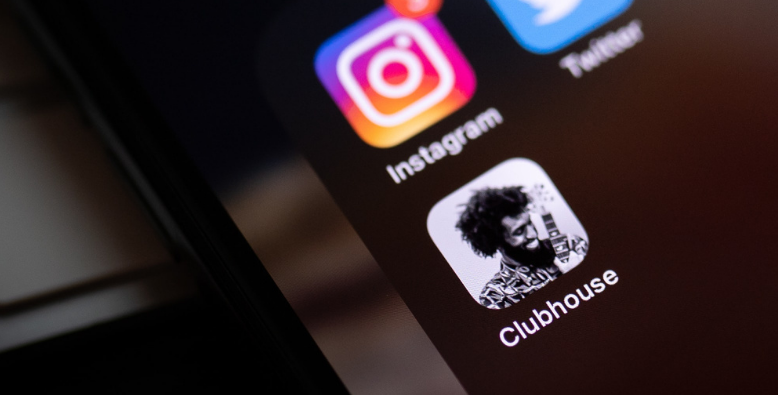Influencer marketing has been a popular tactic in the marketing world for many years now. It’s taken shape in different ways over the years—from fictional figures to celebrities to everyday people acting as ambassadors to brands.
When a marketing tactic and the culture surrounding it evolves as often and as quickly as influencer marketing does, it’s sometimes good to cut through the noise by taking a step back and focusing on what truly makes the marketing tactic effective.
Defining influencer marketing
Merriam-Webster’s dictionary now offers two definitions of the term “influencer.”
They originally defined the term as: (noun) “one who exerts influence: a person who inspires or guides the actions of others.”
In 2019, they added an additional definition of the term: (noun) “a person who is able to generate interest in something (such as a consumer product) by posting about it on social media.”
To me, the new definition sums up how most of us view influencers and influencer marketing today. It typically involves someone with a large following on social media being incentivized by a brand to post about a product or service on their personal social channels (as though they just happened to really want to share this exciting new product with you, organically) with the aim that it will influence others to purchase it. Micro-influencers with smaller followings have been introduced to the mix—but still follow the same transaction and social media sharing processes.
The earlier definition has become more intriguing to me. It doesn’t include a nod to social media (because social media certainly wasn’t around when the term was first used in 1662) and rather focuses on the core of what it means to influence, which is to “inspire” and to “guide” others’ actions.
Influencer marketing and trust
The concept of being an influencer in its original definition can get lost in today’s seemingly glamourous culture of influencers and influencer marketing. This culture conjures an image of big follower counts, attractive young people, specific social platforms and an “influencer aesthetic” of polished photography and consistent colours in content, and calls to action to “swipe up to shop.”
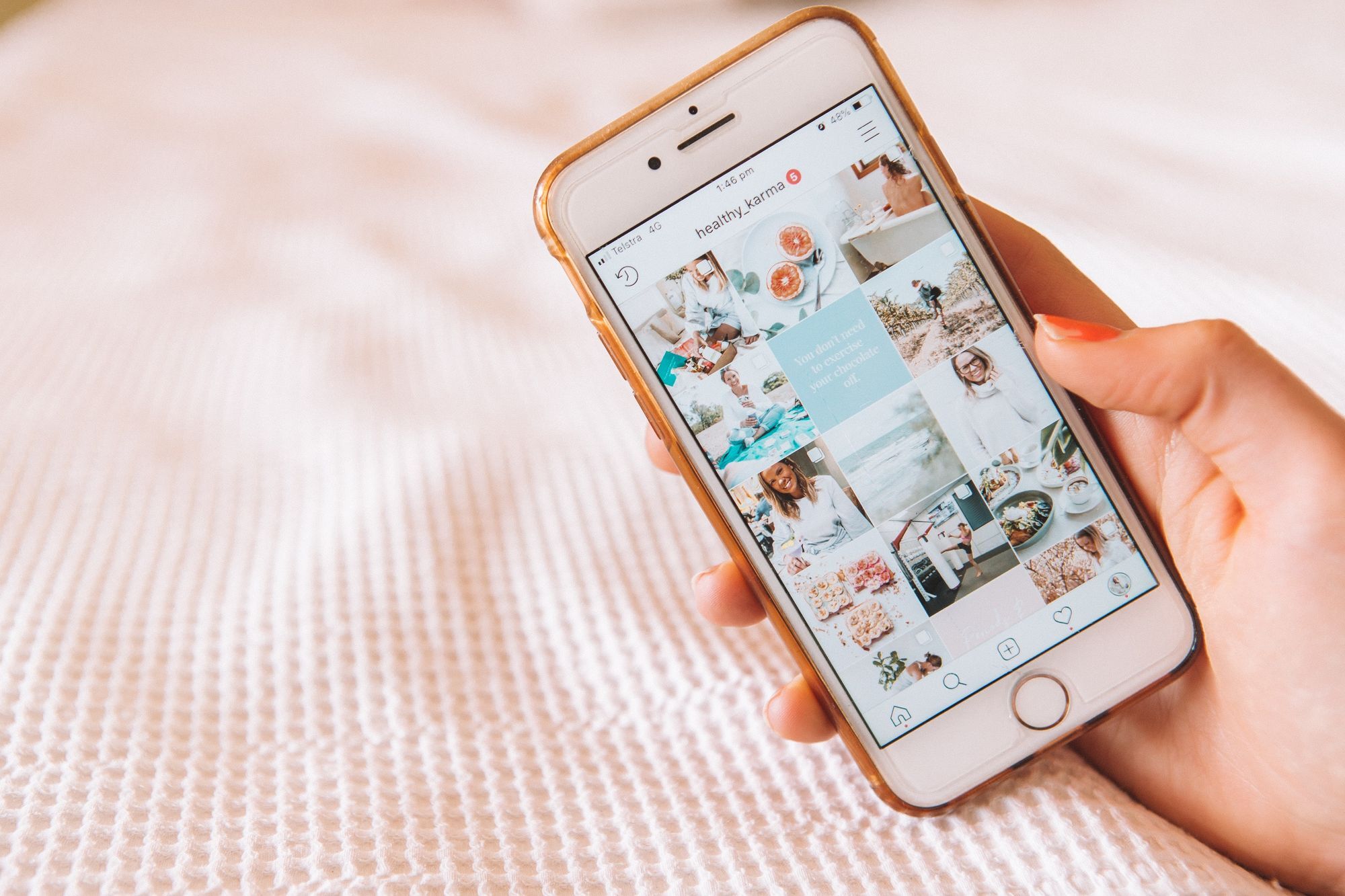
In fact, this influencer culture has become increasingly less trusted over the years. According to a study by Ipsos in August 2020, 48% of US adults surveyed revealed that they distrust influencers on varying levels. A 2019 study from UM found that only 4% of people globally trust information shared by influencers. This has even lead advertising standard organizations and social media platforms to create policies to ensure influencers are more transparent when they post (by including #ad, or “paid partnership” disclaimers, for example).
Knowing that there is growing distrust in influencers—how do you create influencer marketing campaigns that your audience will actually trust?
I think it’s important to look at what it means to influence at its core when creating an influencer marketing strategy, rather than assuming it has to be on a certain social platform and that having a high follower count means you will automatically influence your audience to purchase a product.
To be fair—your influencer marketing strategy may be best suited to social media users who take glossy photos and have big followings on Instagram. Or, it might mean incentivising cab drivers in your city to actually talk to their riders and encourage them to check out your awesome hotel down the street.
It completely depends on who your audience is, what you’re marketing, and how your audience will truly be inspired and guided by a third party.
One thing that is absolute, regardless of the influencer marketing medium, is that in order for an influencer to be effective in marketing, they have to connect with, and be trusted by their audience.
Focus your strategy around understanding your audience first—get to know them, understand their values and why they consume content. Then, go out and find someone who truly emulates your audience so that they content they create is seamlessly aligned with the content that their audience loves.
When you don’t immediately limit yourself to seeking out influencers with thousands of followers or trendy social channels, you’ll start to look at how you can connect with your audience from a different perspective.
We took the approached of seeking out an authentic influencer for an influencer marketing campaign that we created in 2018. It took a less mainstream approach to how the content was created, who the influencer was, the way content was pushed out.
Creating an authentic influencer marketing campaign for Chemo RV
Three years ago, we created a dynamic influencer campaign for our British Columbia-based client, Chemo RV that we named the “Camper Content” program (which we have continued to run featuring different influencers every year since).
This project took months of careful planning to execute. We approached their current market problems with a well-tailored marketing solution—to incorporate influencer marketing into their next campaign.
Chemo RV (pronounced chee-mo) is a family-owned, family-operated RV dealership. Based out of the Cariboo Region in BC, Chemo has a customer base that is largely influenced and categorized by their interior-BC location and Cariboo Region community. Down-to-earth, outdoorsy, and family-oriented are a few terms that can largely sum up the strong characteristics of the market’s demographic.
As mentioned early, influencers typically have a strong social following and has become a sort of online personality through different outlets. They are incorporated into marketing campaigns because they’re popular on social media. Their followers want to emulate them on some level.
While some of the core elements of this concept ring true in our Camper Content program, we took a different approach to our influencer marketing. We didn’t want an influencer who was a professional photographer with a brand-new drone, or a $1000-per-post outdoor apparel model.
Actually, if we were to look at influencer marketing from that lens—we didn’t want an influencer at all. What we wanted was someone who was a true, honest embodiment of who Chemo’s audience is. We wanted the original definition of “influencer”—who would inspire and guide their audience.
We sought to find an authentic influencer who could take a Chemo RV unit out on a couple of Cariboo Region camping trips and create real-experience content from their RV trips (blogs, images, videos) that would be similar to family vacation photos or home videos that someone would show to their family and friends. We then ran this content through Chemo’s Facebook page and website as a seasonal campaign.
Conducting thorough influencer research
The first step of our research process was figuring out what exactly it was that we should be researching to make this project as tight and effective as possible.
Finding the perfect candidate took significant research. We had to learn what type of content was commonly consumed and produced in the Cariboo Region’s social media realm, and which influencer would best fit the bill to create this type of content—while also aligning with the Chemo brand.
There was no glamorous way to find out exactly what type of content was being produced in the Cariboo. We had to roll up our sleeves and look through hundreds of locals’ Instagram accounts. This gave us a real feel for our audience and doubled as a process to find who the best candidate that represented the Cariboo.
After our intensive social-media-creeping research, we selected 15 of our favourite accounts, a.k.a. our potential influencers. We discussed our selections internally, considering each candidate’s capacity to create content (based on our perception of their social accounts), their frequency of creating content, family structure, lifestyle, and whether they seemed to enjoy the outdoors.
After vetting our list of influencers with Chemo, we narrowed our candidates down to a shortlist. We reached out to each of them and explained our Camper Content program.
We wanted to get some virtual face time with our candidates, so we set up video call dates with our final selections. After crafting a list of fundamental questions, we sat down with each of them and got to know them, beyond their Instagram accounts.
We created personalized documents for the candidates that outlined the type of content that we were looking for them to create, and compiled examples of what they’ve posted in the past that we liked—so that they had a sense of their capability to provide us with the content that we want, and what they should consider creating (which was basically the exact type of content they were already creating on their own).
When we finished our interviews, we scored our candidates on our own rubric. We scored based on authenticity, family dynamic, relatability to the audience, reason to camp, visual and writing quality, and our confidence that they would produce the right content. These were the areas of importance that we identified that our candidate had to align with in order for our influencer campaign to have a snug fit with the Chemo brand.
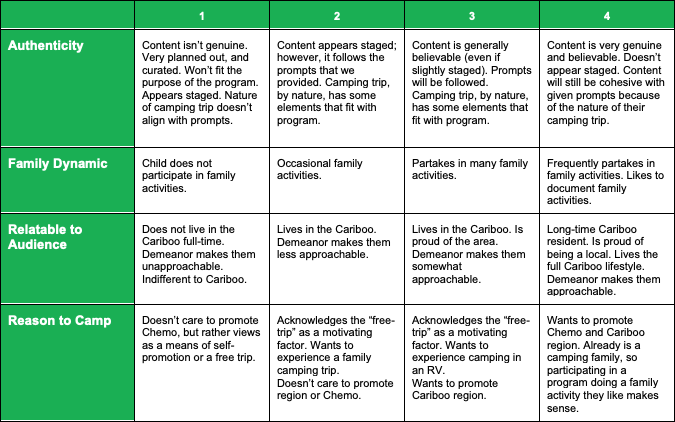
Choosing the best influencer for the campaign
We scored the rubrics and came to the unanimous decision that we had found the quintessence of the Chemo audience—Cariboo-native Josh and his son, Jax. This pair knew the Cariboo like the back of their hands. They loved the outdoors, had adventurous spirits, and valued promoting their beloved community. Their earnestness was contagious. They were the perfect fit. And it was their first time ever doing work as influencers.
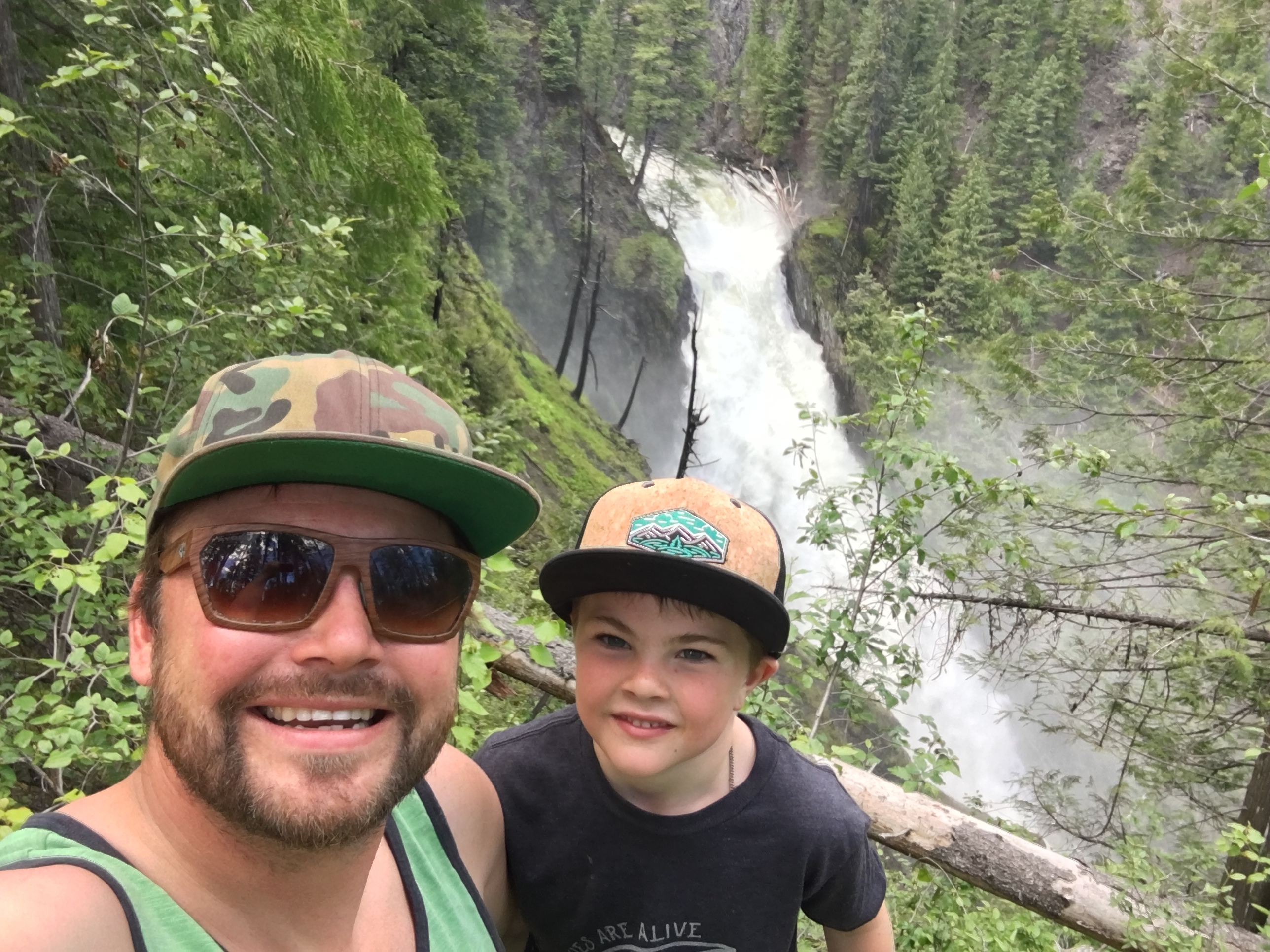
Our agency created a collection of prompts to act as a loose guide for Josh and Jax to follow while creating content on their adventures, as well as a complimentary RV for their camping trips. Our influencers handled the rest—supplies, logistics, and where they wanted to explore.
Josh and Jax went on two separate camping trips. This was constructive for us, as we were able to fully analyze the quality of their content from the first camping trip and had the opportunity to give them feedback on which content we wanted (or, didn’t want) for the second trip.
The campaign played out through organic, boosted Facebook posts over the course of 3 months, which led the user to Josh’s blogs on the Chemo website. Though we used Instagram as our primary platform to find our influencer, Facebook was our platform of choice for this campaign because our audience engaged with this platform more often.
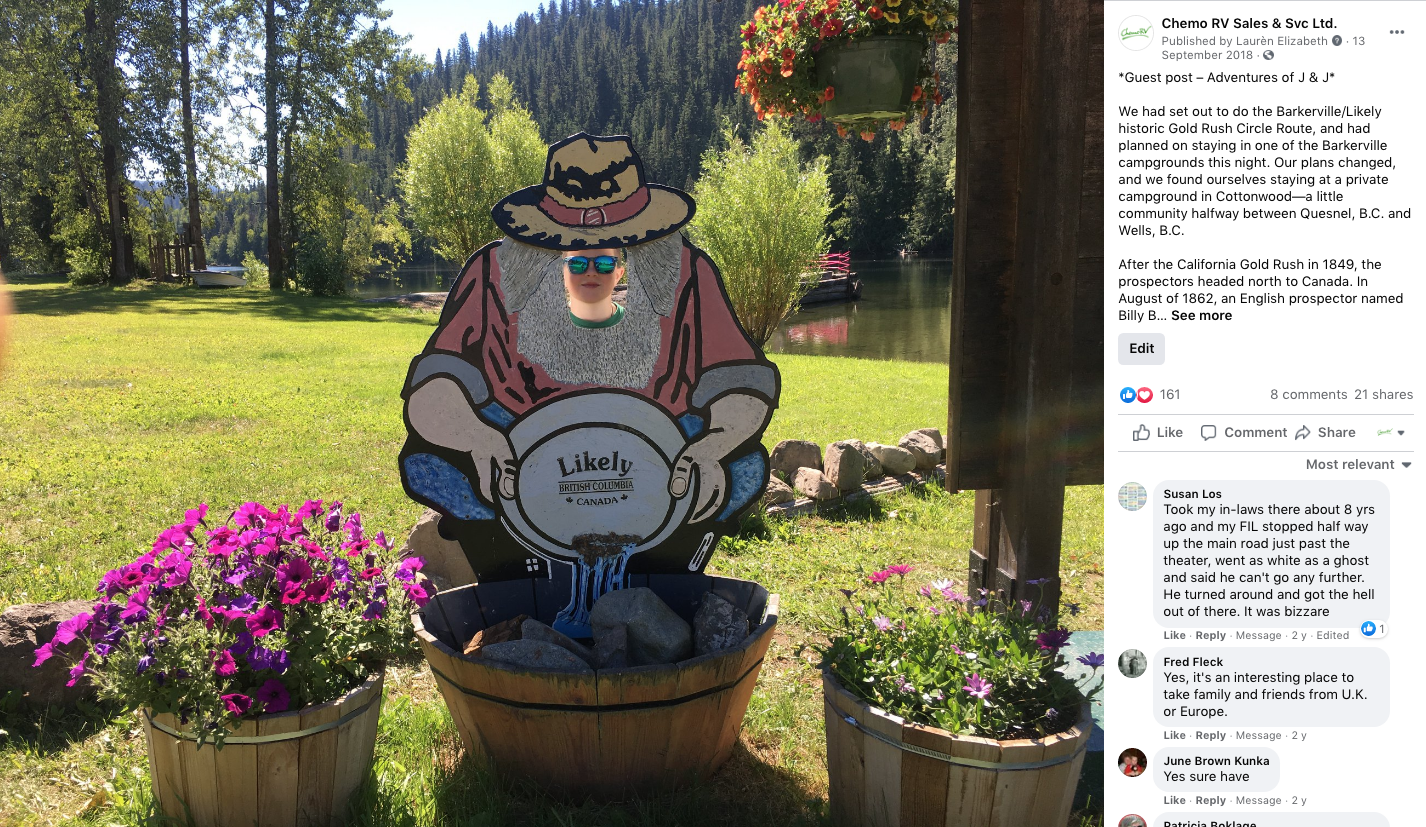

The engagement on Chemo’s Facebook page skyrocketed, as interactions with the Chemo website became more frequent. People were genuinely interested in Josh and Jax’s trip.
The result of the influencer marketing campaign
The organic content from the first camping trip flight generated a 60,000 reach, 2,300 post engagements, 65 shares, an average of 595 visits per blog and up to 3:30 minutes on blog sessions.
The biggest takeaway from this has been the importance of finding the right influencer for the brand.
Most of the success of this campaign was derived from Josh and Jax having been the right fit for the Chemo audience. We worked with influencers that were first and foremost believable and relatable, so the content they created was effortlessly authentic and our audience connected with it.
After doing most of the legwork at the beginning to find the right influencer fit, we found everything went much smoother when it came time to collect content and share it. We had very little critique of the content that Josh put together (we wanted to make sure it was in his own voice and we kept his photos unedited), and we didn’t have to micromanage his camping trips. We were all on the same page. Josh was the expert on what the Cariboo has to offer—we weren’t. He knew what to do, where to go, and what to share with us and the Chemo audience.
Our influencers showed experience, rather than #ads for products. Because they didn’t focus solely on their opinions on their RV features, they were able to connect on a neighbourly level with the Cariboo Region.
The takeaway—always push to give your audience the authentic content that they want to consume and dig deep to find the right person to embody your brand.


